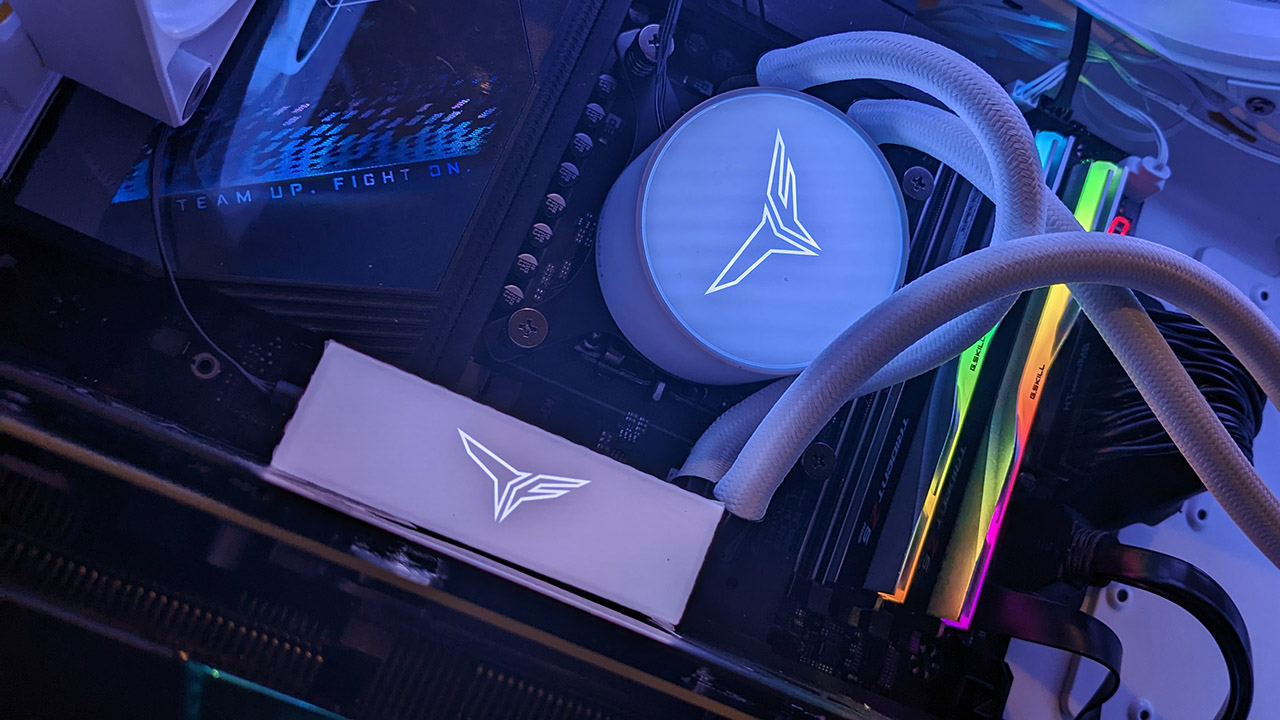
AIO cooling for your CPU. And SSD too!
The era of PCIe 5.0 SSDs is upon us. They’ve been teased and demonstrated for many months. While they’re not yet widely available, you can get one if you want one. But beware, they can get very hot.
Motherboard and cooling manufacturers know this. Many AMD 600-series and Intel 700-series motherboards come with chunky SSD heatsinks. But the problem with those is they typically sit next to a heat dumping graphics card and in some cases will absorb heat rather than dissipate it. Ideally, you want to take the heat of the SSD and extract it. That brings me to the Teamgroup Siren Duo360 AIO cooler. It’s a 360mm CPU cooler, but its main claim to fame is the inclusion of a block to cool a high performance SSD within the loop.
Are you skeptical? Upon hearing about the Siren Duo360, I was too. But after seeing just how nuclear some new SSDs can get, I’m confident in saying there will be many more coolers of this type in the months and years to come.
The Teamgroup Siren Duo360 is certainly innovative, but it comes at a steep price. $399 / AU$599 is a lot to pay for an all-in-one liquid cooler. At that price it’s comfortably more expensive than any other 360mm AIO cooler I’ve come across.
Yep, it’s expensive, but let’s see what this innovative AIO can do before passing judgment. Is it an ultra-luxurious extravagance, or a look at a new future for AIO cooling?
(Image credit: Future)
(Image credit: Future)
(Image credit: Future)
(Image credit: Future)
(Image credit: Future)
The Teamgroup Siren Duo360 is a stylish white themed AIO with hydraulic bearing ARGB fans. It supports almost any socket released over the last decade, with the exception of AMD’s Threadripper range.
(Image credit: Future)
Intel CPU compatibility: LGA 1150/1151/1155/1156/1200/1200/1700/2011/2011-3/2066
AMD CPU compatibility: AM5/AM4/FM2+/FM2/FM1/AM3+/AM3/AM2+/AM2
SSD Compatibility: M.2 2280
Fans: 120mm hydraulic bearing fans x 3
Fan speed: 600-2200 RPM
Noise level: Max 39.5 dB(A)
Pump Speed: 4000 RPM
Radiator dimensions: 396 x 120 x 27mm
Warranty: 2 years
Price: $399 / AU$599
The CPU block is a little more compact that what you might be used to. That’s because the 4000 RPM pump is integrated into the radiator instead of the CPU block. It features lovely diffused ARGB lighting. My review sample featured a finely machined copper base with a nearly mirror like finish. Nice!
Most top-tier AIO coolers come with an integrated LCD display, such as the MSI MEG Coreliquid S360, which the Siren Duo 360 lacks. You be the judge of whether that’s important to you. I understand Teamgroup is focused on the M.2 solution, but I think if you’re going to sell the most expensive AIO on the market, it should come with every conceivable feature.
The M.2 block is the obvious top selling point of the unit. It’s taller than you might expect, partially due to a magnetically attached ARGB unit. That means you could place it elsewhere if you choose to. The block is well built and heavy. The baseplate is clean and very smooth much like the CPU baseplate is.
The bundled T-Force fans are designed with optimal static pressure in mind, and use with radiators. They’re rated to run between 600 to 2200 RPM and have a dBA rating of up to 39.5, which looks high on paper but it’s still under the level I saw in testing.
(Image credit: Future)
For CPU testing over the last couple of years, I’ve used a Ryzen 7 5800X and Asus Crosshair VIII Dark Hero system inside an airflow-restricted Razer Tomahawk ATX case. However, that system lacks PCIe 5.0. So, in this review I’ve also used an Intel Core i9 13900K and Gigabyte Z790 Aorus Master motherboard to test the SSD waterblock. Eventually I will migrate my cooling results over to an updated system that includes PCIe 5.0.
And on the topic of SSD testing, Teamgroup provided a Z540 Cardea 2TB PCIe 5.0 drive. I was asked not to provide specific performance results for this drive as it’s not the same as the retail 12,000MB/s version. Its purpose is to see if PCIe 5.0 drives are as nuclear as we’ve been led to believe and whether M.2 liquid cooling is a gimmick, essential or somewhere in between.
Let’s begin with the CPU cooling results.
When it comes to CPU cooling performance, the Siren Duo360 performed as expected, essentially matching some of the other 360mm AIO coolers I’ve tested. I used a Ryzen 7 5800X inside a closed case for testing in a 22-degree environment and recorded a peak load temperature of 72 degrees.
When it comes to noise levels, the 4000 RPM pump elevated the base noise level a little, but at idle the noise levels of the Duo360 are still perfectly acceptable. However the noise level really ramps up when you push the fans to 100%. In fact, under load its one of the loudest coolers I’ve ever tested. Luckily it shouldn’t need to ramp up to truly annoying levels under typical gaming loads, even with a high core count CPU.
The M.2 cooling results were both surprising and unsurprising, if that makes sense. Firstly, the SSD block has a dramatic effect on the temperatures of the Z540 Cardea SSD. As you can see in the graph above, the temperature drop was an incredible 26°C. I knew it would be cooler, but I didn’t expect it to be at that level. That alone goes a long way to proving the benefit of proper M.2 cooling. A cooler drive should last longer. In theory, fewer large up and down heat cycles will help to protect the drive and its data.
There’s no doubt that water cooling is superior to air cooling in terms of shifting heat away from the drive itself to the radiator. The last thing you need is the heat of a GPU being absorbed into a passive M.2 heatsink, even if it’s a large one.
As I have yet to test any other PCIe 5.0 SSD’s, my data is incomplete. I plan to revisit the topic of SSD cooling as I test more PCIe 5.0 drives, and particularly look out for throttling (or not) across a wide range of benchmarks, both real and synthetic.
I elected to use an internal file copy to thrash the drive’s controller and cache subsystem. I honestly expected the drive to throttle more than it did at a high temperature and it did, but only towards the end of the transfer. A difference of six seconds, or 10% is an improvement to be sure, but that’s after a full minute of 100% load. That kind of load isn’t going to happen too often, and if you’re gaming or primarily performing read operations only, a heavy SSD load will be measured in seconds, and not minutes.
It’s only one drive through. I look forward to testing more drives and seeing the effects the Duo360 has on performance. Is water cooling the way of the future for SSDs? I’m afraid I’ll have to take the lazy option and say the jury is still out, at least until there’s more data for a proper analysis.
(Image credit: Future)
(Image credit: Future)
(Image credit: Future)
The Teamgroup Siren Duo360 is an innovative cooler that will certainly benefit users running hot M.2 SSDs, but only under intensive workloads. It’s generally quiet, though it does get loud when pushed hard.
It’s well built and looks great. Installation is generally easy, though that’s the case for any modern AIO cooler. The use of three ARGB fans plus two blocks means there’s a lot of cable management to be done, but with some good planning and a friendly case, the cables will all but remain hidden.
It’s one for ultra-enthusiasts only.
I really like the Siren Duo360 as a complete cooling package. However, it’s very expensive at $399 USD / AU$599. UK pricing was yet to be revealed, but it’s a safe bet it will cost more than any other 360mm AIO on the market, surely above £400.
So, while it’s for sure an innovative and highly functional cooler, it’s one for ultra-enthusiasts only. Still, I like it. We could be looking at a new class of liquid cooling and one that will surely reveal its potential as the faster PCIe 5.0 drives come on sale in the months ahead.





